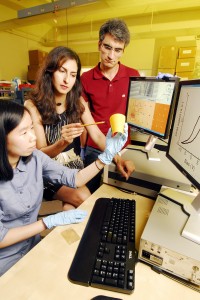Imagine having your chest cracked open every time your pacemaker needs to have its battery changed? It’s not a pleasant thought and researchers are working on a number of approaches to change that situation. Scientists from the University of Michigan have presented the results from some preliminary testing of a device that harvests energy from heartbeats (from the Nov. 4, 2012 news release on EurekAlert),
In a preliminary study, researchers tested an energy-harvesting device that uses piezoelectricity — electrical charge generated from motion. The approach is a promising technological solution for pacemakers, because they require only small amounts of power to operate, said M. Amin Karami, Ph.D., lead author of the study and research fellow in the Department of Aerospace Engineering at the University of Michigan in Ann Arbor.
Piezoelectricity might also power other implantable cardiac devices like defibrillators, which also have minimal energy needs, he said.
Today’s pacemakers must be replaced every five to seven years when their batteries run out, which is costly and inconvenient, Karami said.
A University of Michigan at Ann Arbor March 2, 2012 news release provides more technical detail about this energy-harvesting battery which the researchers had not then tested,
… A hundredth-of-an-inch thin slice of a special “piezoelectric” ceramic material would essentially catch heartbeat vibrations and briefly expand in response. Piezoelectric materials’ claim to fame is that they can convert mechanical stress (which causes them to expand) into an electric voltage.
Karami and his colleague Daniel Inman, chair of Aerospace Engineering at U-M, have precisely engineered the ceramic layer to a shape that can harvest vibrations across a broad range of frequencies. They also incorporated magnets, whose additional force field can drastically boost the electric signal that results from the vibrations.
The new device could generate 10 microwatts of power, which is about eight times the amount a pacemaker needs to operate, Karami said. It always generates more energy than the pacemaker requires, and it performs at heart rates from 7 to 700 beats per minute. That’s well below and above the normal range.
Karami and Inman originally designed the harvester for light unmanned airplanes, where it could generate power from wing vibrations.
Since March 2012, the researchers have tested the prototype (from the Nov. 4, 2012 news release on EurekAlert),
Researchers measured heartbeat-induced vibrations in the chest. Then, they used a “shaker” to reproduce the vibrations in the laboratory and connected it to a prototype cardiac energy harvester they developed. Measurements of the prototype’s performance, based on sets of 100 simulated heartbeats at various heart rates, showed the energy harvester performed as the scientists had predicted — generating more than 10 times the power than modern pacemakers require. The next step will be implanting the energy harvester, which is about half the size of batteries now used in pacemakers, Karami said. Researchers hope to integrate their technology into commercial pacemakers.
There are other teams working on energy-harvesting batteries, in my July 12, 2010 posting I mentioned a team led by Professor Zhong Lin Wang at Georgia Tech (Georgia Institute of Technology in the US) which is working on batteries that harvest energy from biomechanical motion such as heart beats, finger tapping, breathing, etc.


